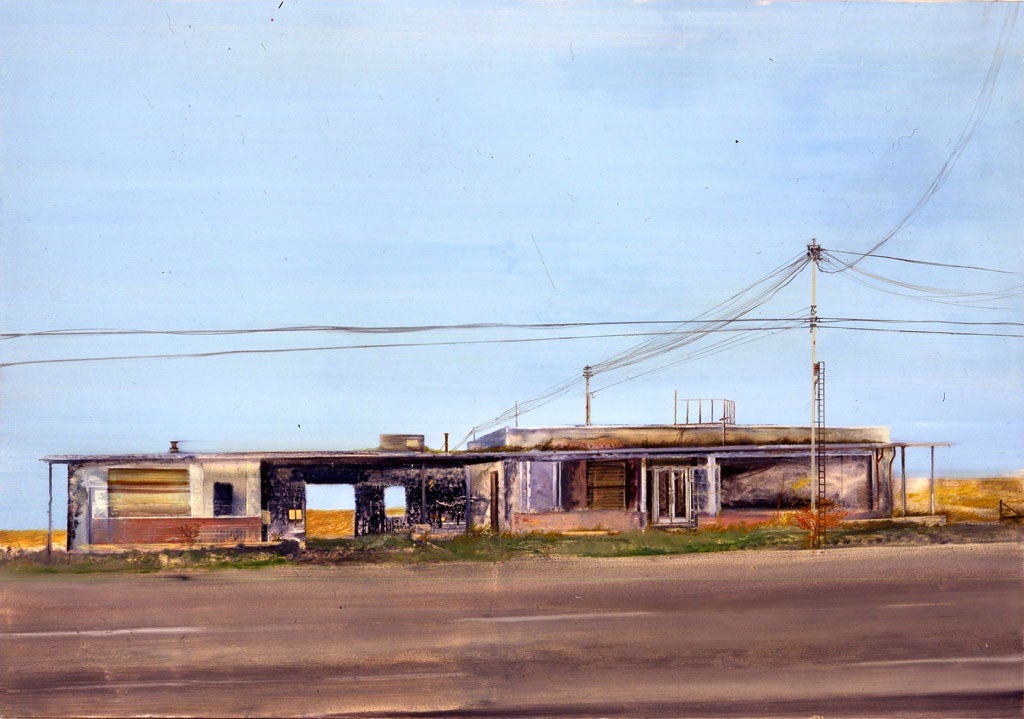Great Works: Somewhere in America, 2000 (178cm x 254cm), Jock McFadyen
Private collection

Sometimes a spasm of perversity strikes: we find ourselves wanting art to take us – transport us if you like (that verb seems entirely appropriate to this particular picture) – to nowhere in particular. We have grown sick of interesting or highly significant subject matter, self-vaunting portraiture, the fanfare of grand buildings in prime architectural locations such as Venice or other places that dress themselves up to look like world-weary grandes dames.
This is such a nowhere place on the page here, and it snatches at our sleeve for that very reason. The title tells us so without our even having to enquire. It informs us that this is a kind of summing up of the identity of certain kinds of spaces or places on the margins of all our lives, posthumous places if you like. The last thing that this painting wants to be is forensically particular, hyper-realistically present to our eye. And it is for this reason that it looks slightly faded, partially rubbed out or scrubbed out as if it apologising for itself. In this case, it is an American place on the margins, set beside what looks like a fairly busy road – it's a wide road, wider than the height of this long, low complex of interlinking buildings in the unmaking. Once, these buildings would have been fresh and new, vitally alive with commerce, human bustle, the cleaning up of coffee spillage.
What we are witnessing here is their sad, wan afterlife beneath a grillingly relentless, tall sky – which, incidentally, takes up most of the picture space . In short, this is neither here nor there. And we do feel for its emptiness – rather in the way that we sometimes we find ourselves slightly regretting, during one of those times between times, that oh dear we don't quite believe in God.
McFadyen is very fond of such places, as is the writer Iain Sinclair, who once wrote an entire book about walking the periphery of the M25. Can you imagine a more God-forsaken spot than that? Which is precisely why Sinclair chose it. These kinds of writers and painters engage us by challenging us to look at everything we would naturally turn away from in indifference or slight disgust – perhaps a mingling of the two. This painting seems to say to us: challenge yourself to look at me for a change. I accept that I am nowhere in particular, but that is no reason to be sniffy about me. It reminds me of a badly expressed snatch of graffiti that I saw on a wall last Saturday morning in Hoxton, east London. It read: "Even the most rubbishy quote when put on a wall can grab your attention". For minutes on end, I couldn't stop myself thinking about the fact that I couldn't stop thinking about those words. I even had to pull up the bike beside the road and write them down. It is often said that poetry is valued for its mnemonic qualities, the fact that it expresses things so beguilingly that you just cannot fail to remember them. But what of a quote such as the one I've just cited or a painting such as this one? These things are memorable too, but part of us feels we feel that they ought not to be. They feel lodged there in spite of our aesthetically hyper-sensitive selves – like a piece of grit in the eye or drinka pinta milka day...
Yes, this painting is almost shockingly ordinary, and it seems, at first glance, to be painted in a way that suggests that the painter too knows in his heart of hearts that it is not up to much. He hasn't tried to paint it up in any way. He hasn't tried to make it seem more than what it is. He has left it looking flat – almost as if fist-flattened – and low and humdrum. There's a slightly simulated world-weariness in the treatment, as if he is not so much painting this place as ticking it off en route to somewhere else, somewhere more glitzy, somewhere worth spending the night, in soul-warming company. This is evidently no such place, beneath the bland glare of a sky that looks as if it will never stop being blue in the way that it is irredeemably blue here. The tiresome regularity of a forever California – that sort of thing. And we are hurrying past it precisely because it is so insignificant – see how those white lines along the highway seem to be blurred, as if in evidence of speeding cars that we never see.
Just as we shall never see any of those humans who would once have lit up this little nook with their snatches of tomfoolery. That blur of speed may be also be evidence of accelerating away from such unpromising subject matter. What is or was this place? A café? A home? Shops beside the road? Its life – such life as it seems to have possessed long before we drew alongside it, so fleetingly – is long since kissed away. In fact, it's hardly a painting that deserves to be in a gallery at all, is it? Or am I wrong about that?
ABOUT THE ARTIST
Jock McFadyen was born in Paisley in 1950, and he describes himself as a realist in the line of Sickert and Lowry. He often sniffs out unremarkable urban locations – derelict cinemas, roadside scenes, vomitories – and paints them with a lonely fidelity to their essences.
Subscribe to Independent Premium to bookmark this article
Want to bookmark your favourite articles and stories to read or reference later? Start your Independent Premium subscription today.

Join our commenting forum
Join thought-provoking conversations, follow other Independent readers and see their replies